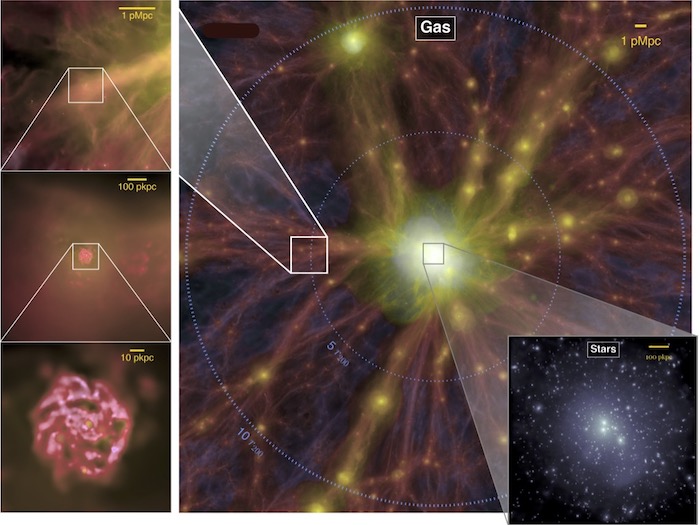Galaxies experience a long strange trip through the cosmic web as they grow and evolve. It turns out that the neighborhoods they spend time in on the journey change their evolution, and that affects their star formation activity and alters their gas content.
Astronomer Gregory Rudnick of the University of Kansas has a grant to follow that galactic growth trail and figure out just how the trip alters the evolution of a galaxy. These giant stellar cities are spread throughout the Universe, said Rudnick, explaining that they tend to cluster together into large conglomerations. Hundreds of thousands of them group together in the largest ones, while smaller ones have only a few. In the grand scheme of things, they can also be part of the filamentary structure called the “cosmic web”. Or, some can be relatively isolated in “low-density” galactic neighborhoods.

How do they get clumped together, and what do they experience as they gather together? That’s what Rudnick and colleagues want to understand. “The primary objective of this project is to comprehend the impact of environmental factors on the transformation of galaxies,” he said.
The Process of Galaxy Evolution
How do these behemoths evolve and grow? A quick look at the history of our Milky Way gives us a good idea of the general story. It began forming as a cloud of hydrogen gas some 13 billion years ago. Gravity pushed the clouds together, which began the process of star formation. Other structures in the galaxy—the core, the flat disk, the halo—formed in quick succession. The infant Milky Way experienced multiple collisions with others throughout its history. It’s still cannibalizing some today. That’s more or less the “executive summary” of galactic growth.
Our Galaxy is part of a larger collection called the Local Group, which is itself part of the Virgo Supercluster. The Virgo collection is also part of a suspected larger grouping called Laniakea. And, all of this is part of the cosmic web that defines large-scale cosmic structure.

How the Trip Changes Galaxies
Rudner’s group plans to focus on the “superhighway” of filaments in the cosmic web, which connects the densest regions in the Universe. The team will focus on how galaxies react to the environment inside filaments as they get channeled into clusters. That trip seems to alter them as they traverse the web.
“Galaxies follow a path into these filaments, experiencing a dense environment for the first time before progressing into groups and clusters,” Rudnick said. “Studying galaxies in filaments allows us to examine the initial encounters of galaxies with dense environments. The majority of galaxies entering the ‘urban centers’ of clusters do so along these ‘superhighways,’ with only a minimal number taking rural routes that bring them into the clusters and groups without interacting much with their surroundings.”

Tracing the Baryon Cycle
Rudner and his team want to see how conditions where galaxies congregate alter the gases in and around them. Filaments, fields, groups, and clusters all have different environments. Each of these neighborhoods affects gas behavior. Astronomers think of these changes in terms of a “baryon cycle”. That’s a complex phenomenon, actually. It describes all the ways that gas is processed in dense clusters and filaments of the cosmic web.
“The space between galaxies contains gas. Indeed, most of the atoms in the universe are in this gas, and that gas can accrete onto the galaxies,” Rudnick said. “This intergalactic gas undergoes a transformation into stars, although the efficiency of this process is relatively low, with only a small percentage contributing to star formation. The majority is expelled in the form of large winds.”
Think of galaxies as baryon processing engines, drawing gas from the intergalactic medium and converting some of it into stars. Stellar populations produce heavier elements as they evolve. Eventually all material ends up in space, along with the gas, forming a fountain that eventually falls back to the galaxy. When they move into a denser environment, the pressure of their passage disrupts the baryon cycle. It removes galactic gas or in some way deprives it of the “stuff” it needs to make new stars. This has happened in the centers of clusters. “The disruption affects the intake and expulsion of gas by galaxies, leading to alterations in their star formation processes,” Rudner said. “While there may be a temporary increase in star formation, in nearly all cases, it eventually results in a decline in star formation.”
Tracking Galaxies
For their work in tracing the long strange trips that galaxies take, Rudner and his team will comb through astronomical datasets from the DESI, WISE, and GALEX programs. This will give them access to some 14,000 galaxies to study. They’ll also get new images of galaxies to study. Students from the university, as well as selected high schools, will also take part in the study.
The grant funds a high school astronomy class affiliated with Siena College and extends a course already offered at Lawrence High School close to KU’s Lawrence campus. “These funds will extend the high school program’s longevity through 2026,” Rudnick said. “In collaboration with funds from KU, we were able to purchase 11 MacBook Pros for the school. Given that students only have iPads, which aren’t suitable for the research activities they needed to undertake, this grant facilitated the acquisition of computers that will enable their research.”
Ultimately, the extended team’s work should uncover more about the long-term evolution of galaxies, starting in the early Universe and extending to the modern cosmos. In addition, it will reveal more about the cosmic web and filaments that make up the large-scale structure that defines the Universe.
For More Information
Researchers Seek to Understand how Regions of “Cosmic Web” Influence Behavior of Galaxies

